2005 CHEVROLET EXPRESS PASSANGER ECU
[x] Cancel search: ECUPage 48 of 388
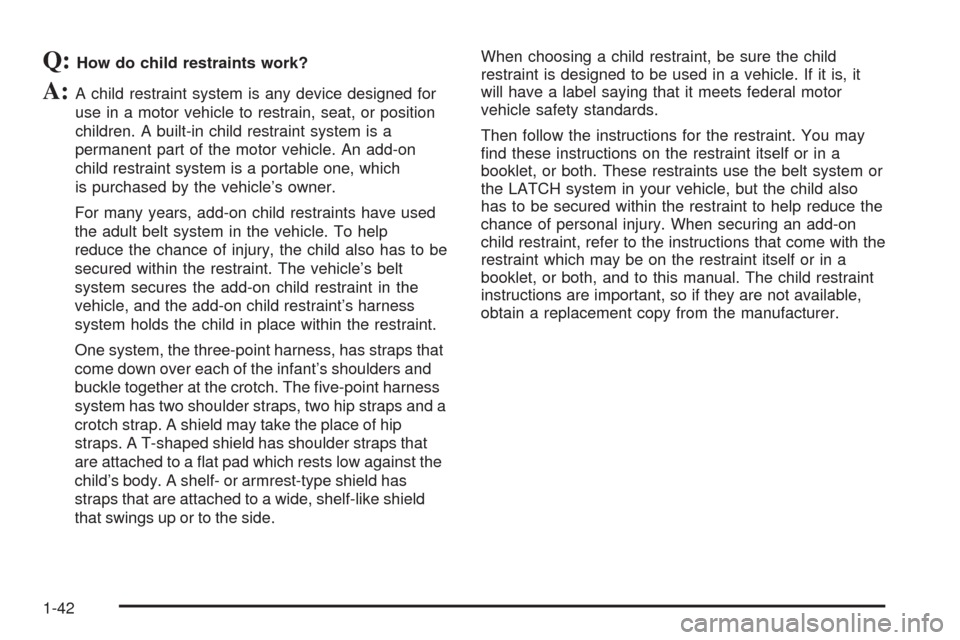
Q:How do child restraints work?
A:A child restraint system is any device designed for
use in a motor vehicle to restrain, seat, or position
children. A built-in child restraint system is a
permanent part of the motor vehicle. An add-on
child restraint system is a portable one, which
is purchased by the vehicle’s owner.
For many years, add-on child restraints have used
the adult belt system in the vehicle. To help
reduce the chance of injury, the child also has to be
secured within the restraint. The vehicle’s belt
system secures the add-on child restraint in the
vehicle, and the add-on child restraint’s harness
system holds the child in place within the restraint.
One system, the three-point harness, has straps that
come down over each of the infant’s shoulders and
buckle together at the crotch. The �ve-point harness
system has two shoulder straps, two hip straps and a
crotch strap. A shield may take the place of hip
straps. A T-shaped shield has shoulder straps that
are attached to a �at pad which rests low against the
child’s body. A shelf- or armrest-type shield has
straps that are attached to a wide, shelf-like shield
that swings up or to the side.When choosing a child restraint, be sure the child
restraint is designed to be used in a vehicle. If it is, it
will have a label saying that it meets federal motor
vehicle safety standards.
Then follow the instructions for the restraint. You may
�nd these instructions on the restraint itself or in a
booklet, or both. These restraints use the belt system or
the LATCH system in your vehicle, but the child also
has to be secured within the restraint to help reduce the
chance of personal injury. When securing an add-on
child restraint, refer to the instructions that come with the
restraint which may be on the restraint itself or in a
booklet, or both, and to this manual. The child restraint
instructions are important, so if they are not available,
obtain a replacement copy from the manufacturer.
1-42
Page 49 of 388
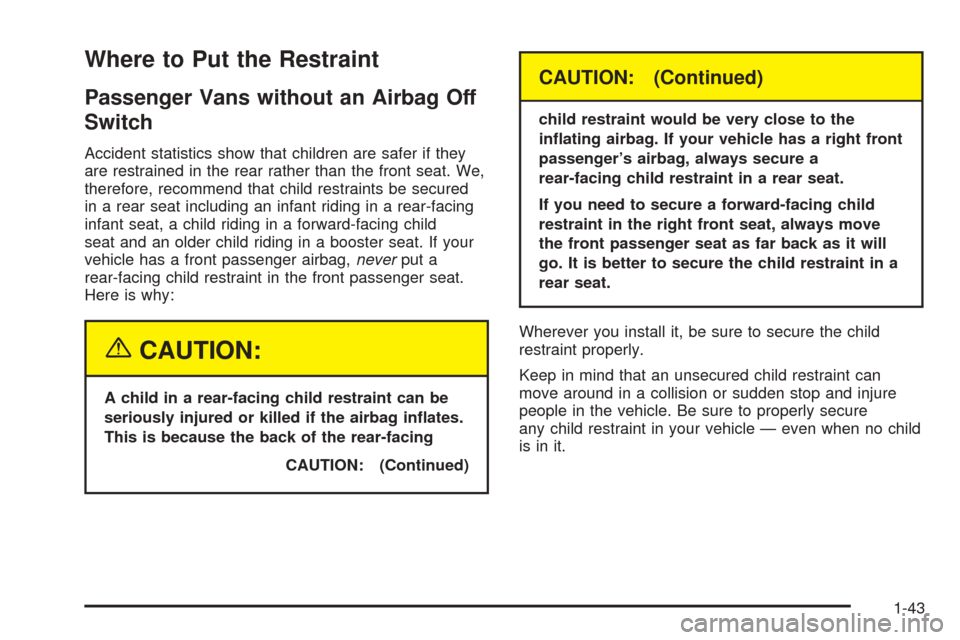
Where to Put the Restraint
Passenger Vans without an Airbag Off
Switch
Accident statistics show that children are safer if they
are restrained in the rear rather than the front seat. We,
therefore, recommend that child restraints be secured
in a rear seat including an infant riding in a rear-facing
infant seat, a child riding in a forward-facing child
seat and an older child riding in a booster seat. If your
vehicle has a front passenger airbag,neverput a
rear-facing child restraint in the front passenger seat.
Here is why:
{CAUTION:
A child in a rear-facing child restraint can be
seriously injured or killed if the airbag in�ates.
This is because the back of the rear-facing
CAUTION: (Continued)
CAUTION: (Continued)
child restraint would be very close to the
in�ating airbag. If your vehicle has a right front
passenger’s airbag, always secure a
rear-facing child restraint in a rear seat.
If you need to secure a forward-facing child
restraint in the right front seat, always move
the front passenger seat as far back as it will
go. It is better to secure the child restraint in a
rear seat.
Wherever you install it, be sure to secure the child
restraint properly.
Keep in mind that an unsecured child restraint can
move around in a collision or sudden stop and injure
people in the vehicle. Be sure to properly secure
any child restraint in your vehicle — even when no child
is in it.
1-43
Page 50 of 388
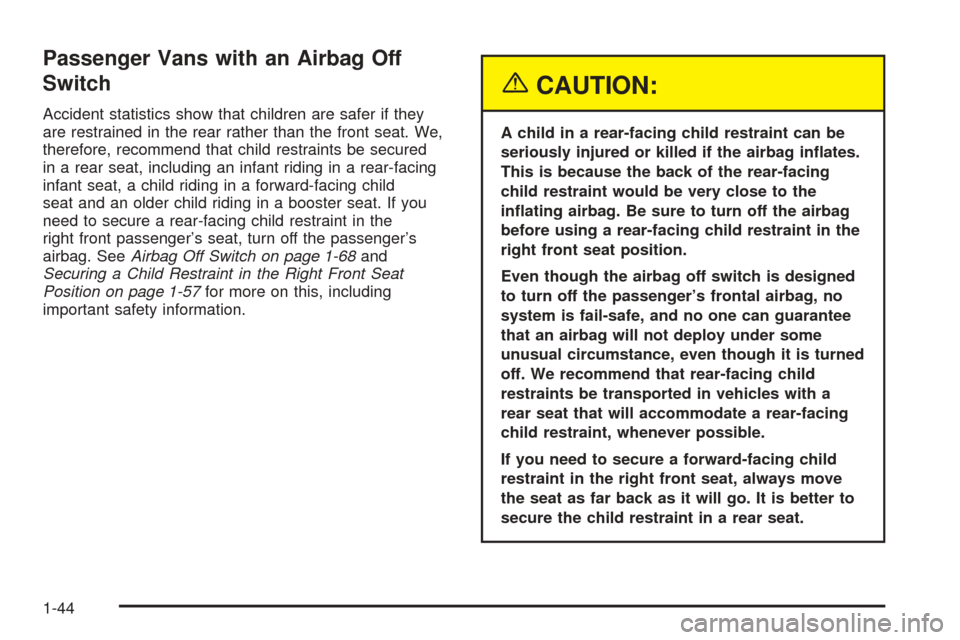
Passenger Vans with an Airbag Off
Switch
Accident statistics show that children are safer if they
are restrained in the rear rather than the front seat. We,
therefore, recommend that child restraints be secured
in a rear seat, including an infant riding in a rear-facing
infant seat, a child riding in a forward-facing child
seat and an older child riding in a booster seat. If you
need to secure a rear-facing child restraint in the
right front passenger’s seat, turn off the passenger’s
airbag. SeeAirbag Off Switch on page 1-68and
Securing a Child Restraint in the Right Front Seat
Position on page 1-57for more on this, including
important safety information.
{CAUTION:
A child in a rear-facing child restraint can be
seriously injured or killed if the airbag in�ates.
This is because the back of the rear-facing
child restraint would be very close to the
in�ating airbag. Be sure to turn off the airbag
before using a rear-facing child restraint in the
right front seat position.
Even though the airbag off switch is designed
to turn off the passenger’s frontal airbag, no
system is fail-safe, and no one can guarantee
that an airbag will not deploy under some
unusual circumstance, even though it is turned
off. We recommend that rear-facing child
restraints be transported in vehicles with a
rear seat that will accommodate a rear-facing
child restraint, whenever possible.
If you need to secure a forward-facing child
restraint in the right front seat, always move
the seat as far back as it will go. It is better to
secure the child restraint in a rear seat.
1-44
Page 51 of 388
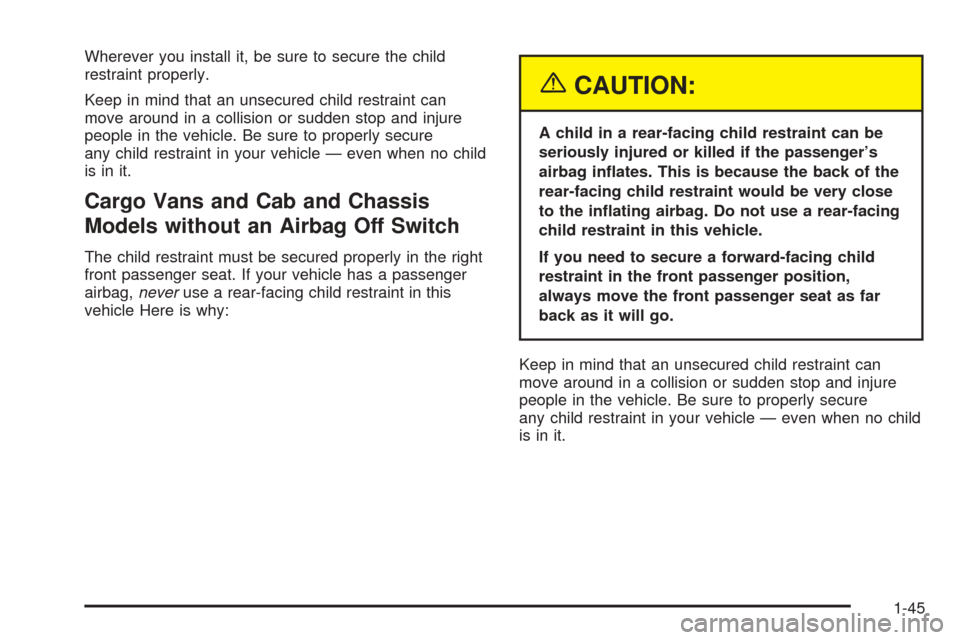
Wherever you install it, be sure to secure the child
restraint properly.
Keep in mind that an unsecured child restraint can
move around in a collision or sudden stop and injure
people in the vehicle. Be sure to properly secure
any child restraint in your vehicle — even when no child
is in it.
Cargo Vans and Cab and Chassis
Models without an Airbag Off Switch
The child restraint must be secured properly in the right
front passenger seat. If your vehicle has a passenger
airbag,neveruse a rear-facing child restraint in this
vehicle Here is why:
{CAUTION:
A child in a rear-facing child restraint can be
seriously injured or killed if the passenger’s
airbag in�ates. This is because the back of the
rear-facing child restraint would be very close
to the in�ating airbag. Do not use a rear-facing
child restraint in this vehicle.
If you need to secure a forward-facing child
restraint in the front passenger position,
always move the front passenger seat as far
back as it will go.
Keep in mind that an unsecured child restraint can
move around in a collision or sudden stop and injure
people in the vehicle. Be sure to properly secure
any child restraint in your vehicle — even when no child
is in it.
1-45
Page 52 of 388
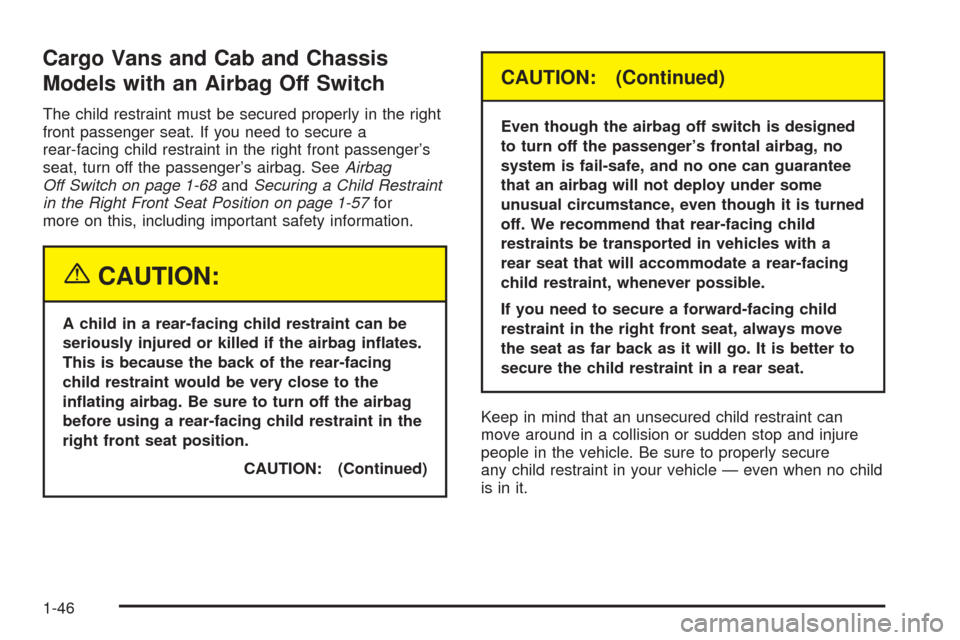
Cargo Vans and Cab and Chassis
Models with an Airbag Off Switch
The child restraint must be secured properly in the right
front passenger seat. If you need to secure a
rear-facing child restraint in the right front passenger’s
seat, turn off the passenger’s airbag. SeeAirbag
Off Switch on page 1-68andSecuring a Child Restraint
in the Right Front Seat Position on page 1-57for
more on this, including important safety information.
{CAUTION:
A child in a rear-facing child restraint can be
seriously injured or killed if the airbag in�ates.
This is because the back of the rear-facing
child restraint would be very close to the
in�ating airbag. Be sure to turn off the airbag
before using a rear-facing child restraint in the
right front seat position.
CAUTION: (Continued)
CAUTION: (Continued)
Even though the airbag off switch is designed
to turn off the passenger’s frontal airbag, no
system is fail-safe, and no one can guarantee
that an airbag will not deploy under some
unusual circumstance, even though it is turned
off. We recommend that rear-facing child
restraints be transported in vehicles with a
rear seat that will accommodate a rear-facing
child restraint, whenever possible.
If you need to secure a forward-facing child
restraint in the right front seat, always move
the seat as far back as it will go. It is better to
secure the child restraint in a rear seat.
Keep in mind that an unsecured child restraint can
move around in a collision or sudden stop and injure
people in the vehicle. Be sure to properly secure
any child restraint in your vehicle — even when no child
is in it.
1-46
Page 54 of 388
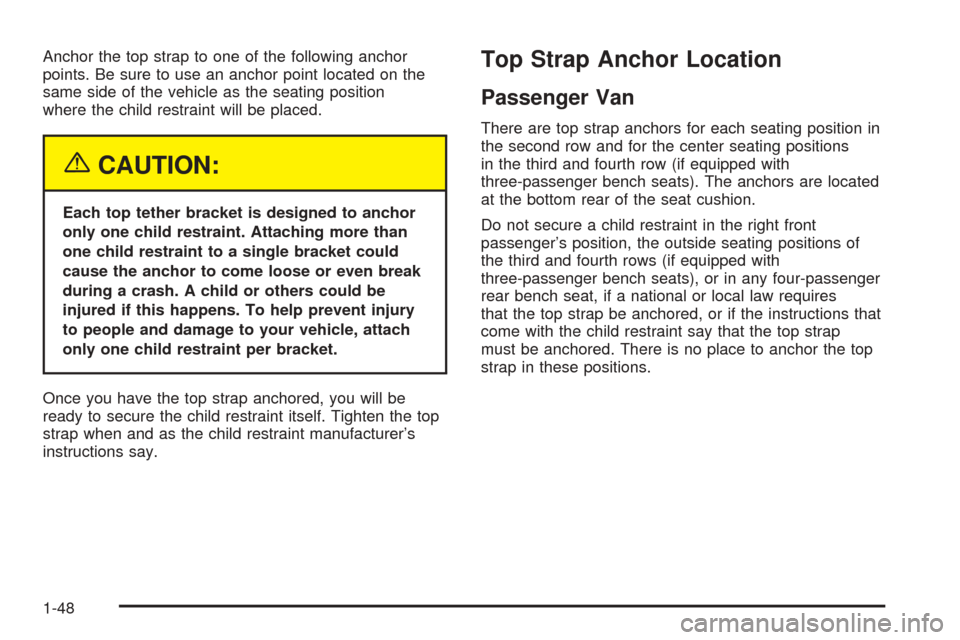
Anchor the top strap to one of the following anchor
points. Be sure to use an anchor point located on the
same side of the vehicle as the seating position
where the child restraint will be placed.
{CAUTION:
Each top tether bracket is designed to anchor
only one child restraint. Attaching more than
one child restraint to a single bracket could
cause the anchor to come loose or even break
during a crash. A child or others could be
injured if this happens. To help prevent injury
to people and damage to your vehicle, attach
only one child restraint per bracket.
Once you have the top strap anchored, you will be
ready to secure the child restraint itself. Tighten the top
strap when and as the child restraint manufacturer’s
instructions say.
Top Strap Anchor Location
Passenger Van
There are top strap anchors for each seating position in
the second row and for the center seating positions
in the third and fourth row (if equipped with
three-passenger bench seats). The anchors are located
at the bottom rear of the seat cushion.
Do not secure a child restraint in the right front
passenger’s position, the outside seating positions of
the third and fourth rows (if equipped with
three-passenger bench seats), or in any four-passenger
rear bench seat, if a national or local law requires
that the top strap be anchored, or if the instructions that
come with the child restraint say that the top strap
must be anchored. There is no place to anchor the top
strap in these positions.
1-48
Page 56 of 388
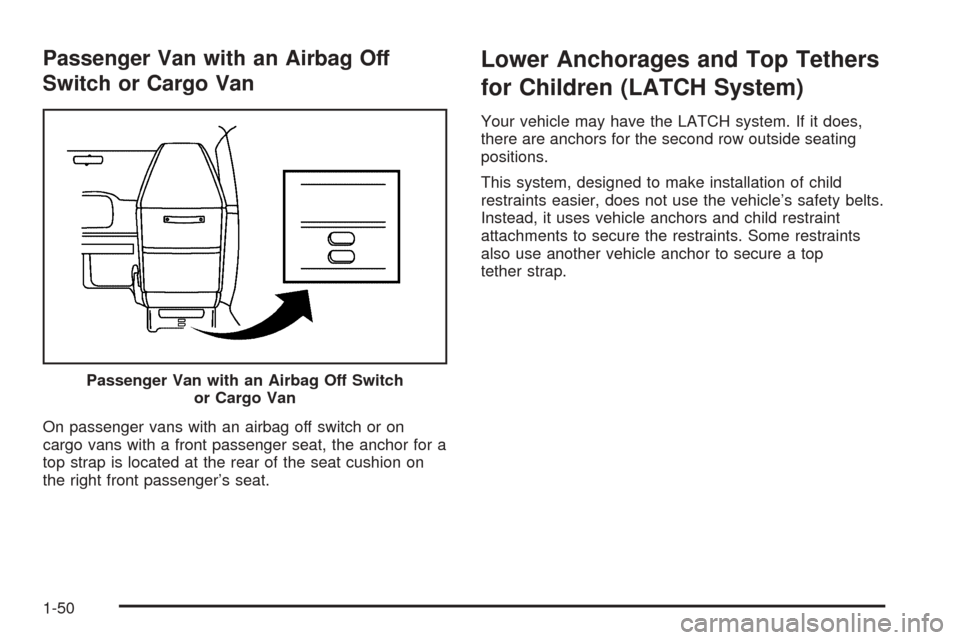
Passenger Van with an Airbag Off
Switch or Cargo Van
On passenger vans with an airbag off switch or on
cargo vans with a front passenger seat, the anchor for a
top strap is located at the rear of the seat cushion on
the right front passenger’s seat.
Lower Anchorages and Top Tethers
for Children (LATCH System)
Your vehicle may have the LATCH system. If it does,
there are anchors for the second row outside seating
positions.
This system, designed to make installation of child
restraints easier, does not use the vehicle’s safety belts.
Instead, it uses vehicle anchors and child restraint
attachments to secure the restraints. Some restraints
also use another vehicle anchor to secure a top
tether strap.
Passenger Van with an Airbag Off Switch
or Cargo Van
1-50
Page 58 of 388

The LATCH system labels are located in the second
row outside seating positions.
{CAUTION:
If a LATCH-type child restraint is not attached
to its anchorage points, the restraint will not
be able to protect the child correctly. In a
crash, the child could be seriously injured or
killed. Make sure that a LATCH-type child
restraint is properly installed using the
anchorage points, or use the vehicle’s safety
belts to secure the restraint, following the
instructions that came with that restraint, and
also the instructions in this manual.
Securing a Child Restraint Designed
for the LATCH System
1. Find the LATCH anchorages for the seating
position you want to use, where the bottom of the
seatback meets the back of the seat cushion.
SeeLower Anchorages and Top Tethers for
Children (LATCH System) on page 1-50.
2. Put the child restraint on the seat.
3. Attach and tighten the LATCH attachments on the
child restraint to the LATCH anchorages in the
vehicle. The child restraint instructions will show
you how.
4. If the child restraint is forward-facing, attach and
tighten the top tether to the top tether anchorage.
The child restraint instructions will show you
how. Also seeTop Strap on page 1-47.
5. Push and pull the child restraint in different
directions to be sure it is secure.
To remove the child restraint, simply unhook the top
tether from the top tether anchorage and then
disconnect the LATCH attachments from the LATCH
anchorages.
1-52